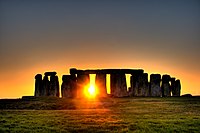English Heritage


The Historic Building and Monuments Commission for England, usually known as English Heritage,[1] is a British government body charged with managing the historic built environment of England and advising the relevant Secretary of State on policy generally and in individual cases such as registering listed buildings and scheduled ancient monuments. The equivalent state bodies elsewhere in the kingdom are:
- Cadw (Wales)
- Historic Scotland
- The Northern Ireland Environment Agency
The Historic Building and Monuments Commission for England is an executive non-departmental public body (a "quango") sponsored by the Department for Culture, Media and Sport (DCMS). It was set up under the terms of the National Heritage Act 1983. Its functions for maintaining ancient monuments had previously been undertaken by part of the Department of the Environment which was the successor to the Ministry of Works. The 1983 Act also dissolved the bodies that had hitherto provided independent advice — the Ancient Monuments Board for England and the Historic Buildings Council for England and incorporated these functions in the new body. Another advisory body, the Royal Commission on the Historical Monuments of England (RCHME) was not merged with English Heritage until 1 April 1999.[2]
English Heritage's best known public role is as the steward of over 400 significant historical and archaeological sites, from Stonehenge to the world's earliest iron bridge, at Ironbridge in Shropshire. It has direct ownership over some historic sites while others in private hands may be managed under guardianship arrangements.
English Heritage has major responsibilities in conservation, giving advice, registering and protecting the historic environment. It also maintains a public archive, the National Monuments Record.
Properties
English Heritage is the guardian of over 400 sites and monuments, the most famous of which include Stonehenge, the Iron Bridge and Dover Castle. Whilst many have an entry charge, more than 250 properties are free to enter[3] including Maiden Castle, Dorset and St Catherine's Oratory.
The properties are part of the portfolio of over 880 sites amassed by the British Government between the 1880s and the 1970s to form the National Collection of built and archaeological heritage; the rest are in the care of the Northern Ireland Environment Agency, Historic Scotland and CADW.) These sites represent a deliberate attempt by the state in the 19th and early 20th century to take the nation’s most significant prehistoric sites and mediæval sites, which were no longer in active use, into public ownership.[4] This national property collection performs the same function as pictures in the National Gallery and the archaeological material in the British Museum.
Unlike the National Trust, English Heritage holds few furnished properties. New sites are rarely added to the collection as other charities and institutions are now encouraged to care for them and open them to the public.[4]
The properties are held by English Heritage under various arrangements. The majority are in the guardianship of the Secretary of State for the Department for Culture, Media and Sport with the freehold being retained by the owner. The remaining properties are either owned by English Heritage, other government departments or the Crown Estate.[5]
In 2009-2010 there were 5.6 million visits to staffed properties, an estimated 6 million visits to unstaffed sites and a further 30,800 free educational visits.[5]
Images of England
Images of England is an English Heritage project intended to create a freely accessible online database of the 370,000 listed properties in England. Each database entry includes a representative photograph and a description of the building written by an expert architectural historian.
History
Over the centuries, what is now called 'heritage' has been the responsibility of a series of state departments, perhaps traceable as far as the 'Kings Works', known soon after the Norman Conquest. In later ages were found: the 'Office of Works' (1378-1832); The Office of Woods, Forests, Land Revenues and Works (1832–1851); and the Ministry of Works (1851–1962). Responsibility subsequently transferred to the Ministry of Public Building and Works (1962–1970) then to the Department of the Environment (1970–1997) and now the Department of Culture, Media and Sport.[6]
The state took a hand in consrrvation first under the Ancient Monuments Protection Act 1882, then after the Second World War began the listed buildings regime, and conservation areas were introduced in the 1960s. In 1983 Secretary of State for the Environment Michael Heseltine gave national responsibility for the historic environment to a semi‑autonomous agency (or 'quango') to operate under ministerial guidelines and to government policy. The Historic Buildings and Monuments Commission (now known as English Heritage) was formed.[7]
A national register of historic parks and gardens was set up in 1984,[8] and a register for historic battlefields was created in March 1995.[9] ‘Registration’ is a material consideration in the planning process. In April 1999 English Heritage merged with the Royal Commission on the Historical Monuments of England and the National Monuments Record. English Heritage also took responsibility for the national record of archaeological sites from the Ordnance Survey; the National Library of Aerial Photographs, and two million RAF and Ordnance Survey aerial photographs.
Under the National Heritage Act 2002, English Heritage also acquired administrative responsibility for historic wrecks and submerged landscapes within 12 miles of the coast of England.[10]
The administration of the listed building system was transferred from DCMS to English Heritage in 2006. However, actual listing decisions still remain the responsibility of the Secretary of State for Culture, Media and Sport, who is required by the Planning (Listed Buildings and Conservation Areas) Act 1990 to approve a list of buildings of special architectural or historic interest, and his approval is no mere formality; he will frequently refuse to list a building.
English Heritage is only one of several of government sponsored organisations with responsibility for the historic environment.[11]
See also
- Equivalent state bodies:
- Cadw
- Historic Scotland
- Manx National Heritage
- Northern Ireland Environment Agency (formerly the Environment and Heritage Service)
- National Trust bodies:
References
- ↑ Who We Are About Us English Heritage
- ↑ Conservation Bulletin, Issue 35, April 1999
- ↑ "See English Heritage history for free". http://www.countrylife.co.uk/property/article/521324/See-English-Heritage-history-for-free.html. Retrieved 10 May 2011.
- ↑ 4.0 4.1 "English Heritage Information Pack 2010". http://www.english-heritage.org.uk/about/who-we-are/corporate-information/information-pack/. Retrieved 10 May 2011.
- ↑ 5.0 5.1 English Heritage 2009-2010 Annual Report and Accounts
- ↑ English Heritage leaflet "The evolution of the National Monument Record"
- ↑ "National Heritage Act 1983". http://www.legislation.gov.uk/ukpga/1983/47/crossheading/historic-buildings-and-monuments-commission-for-england. Retrieved 13 May 2011.
- ↑ Historic Buildings and Monuments Commission for England: "Report and Accounts 1983-1985" p26
- ↑ English Heritage Annual Report and Accounts "Working in Partnership" 1994/1995 p 6 & 41
- ↑ "National Heritage Act 2002". http://www.legislation.gov.uk/ukpga/2002/14/contents. Retrieved 13 May 2011.
- ↑ "Protecting the Historic Environment". http://www.culture.gov.uk/what_we_do/historic_environment/6258.aspx. Retrieved 13 May 2011.